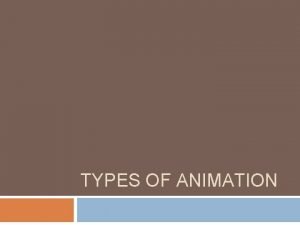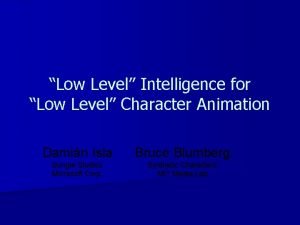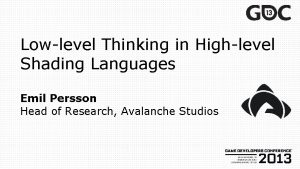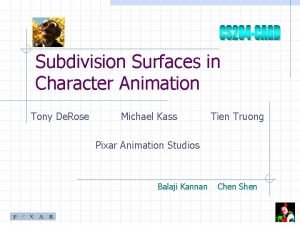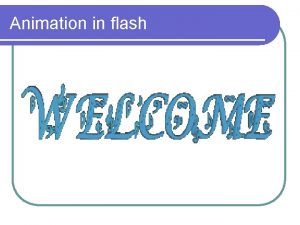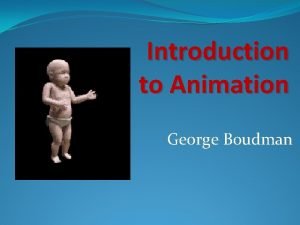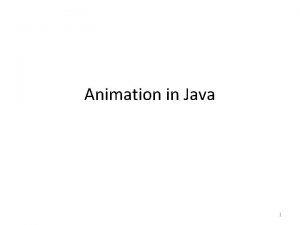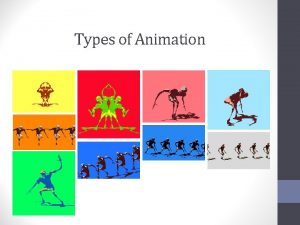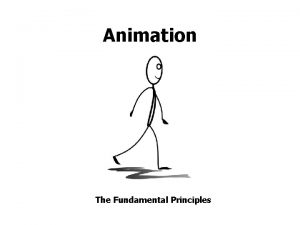Low Level Intelligence for Low Level Character Animation














- Slides: 14

“Low Level” Intelligence for “Low Level” Character Animation Damián Isla Bruce Blumberg Bungie Studios Microsoft Corp. Synthetic Characters MIT Media Lab

“Low level” Animation …? n Animation not having to do with gross body movement or “behavior” – – – n Eye gaze Facial expression Ambient / idling animation Animation style Speech? Interesting because an “internal life” is implied

Cognitive Modeling CM: Giving characters an internal life Pros Cons Unpredictability Responsiveness Leverage animation Unpredictability Reproducibility Controllability Too much autonomy?

“Low level” Cognition …? A class of abilities that are relevant to, but independent of, high-level action n n n Perception Knowledge modeling Attention Memory Emotional reaction Motion quality …

Example 1: Alpha. Wolf n Emotional memories: player has total control, but wolves react to instructions based on past experience n n Wolves maintain their own cognition, memory and emotion models B. Tomlinson, “Synthetic Social Relationships for Computational Entities”, Ph. D. Thesis, MIT Media Lab 2002

Example 2: Object Persistence n Piaget: The persistence of a mental image after the sensory stimulus has been removed Object Persistence = location expectation formation n Focus on search tasks (where do I expect the sheep to be? ) n

Spatial Expectations Probabilistic Occupancy Map – Discrete spatial probability distribution – Uncertainty through discrete diffusion

POM Algorithm If target observed: Find closest node n* Otherwise: Divide map nodes into visible (V) and nonvisible (N) sets Either way: Diffuse Probability

Emergent Look-Around n Simple rule: always direct gaze towards most likely location of the target n Also: Emergent Search

Expectations and Emotions Observations can have emotional impact – Wanted to see something but didn’t confusion – Saw something where you didn’t expect it to be surprise – Having trouble finding the target frustration … plus variations – – – Target desired + confusion disappointment Target feared + surprise panic Target desired + surprise delight Emotions may – – Focus attention (salience) Bias behavioral choices / Affect decision-making parameters Affect animation (facial and parameterized) Act as a debugging channel!

Expectations and Emotions n Emotional Autonomic variable n Surprise (unexpected observation) n Confusion (negated expectation) – Proportional to amount of culled probability n Frustration (consistently negated expectations)

Results: Duncan the Highland Terrier Duncan: n Virtual sheep-herding n Layered behavior system n Synthetic vision Results: n Emergent look-around n Emergent search n Salient Moving objects n Distribution-based object-mapping n Emotional reactions – Surprise – Confusion – Frustration Video

Conclusions n “Low Level” Conclusions – A model of Object Persistence – Simple mechanism, complex results § Simplementation § Intuitive n “High Level” Conclusion – Intelligence >> Action-selection § You control the wolves, but what they feel matters § You control Duncan, but what he knows matters

Questions? Damián Isla Bruce Blumberg naimad@media. mit. edu http: //www. media. mit. edu/~naimad bruce@media. mit. edu http: //www. media. mit. edu/~bruce Synthetic Characters http: //www. media. mit. edu/characters
 Traditional animation vs computer animation
Traditional animation vs computer animation Low level character
Low level character Low-level thinking in high-level shading languages
Low-level thinking in high-level shading languages Subdivision surfaces in character animation
Subdivision surfaces in character animation Character animation adobe
Character animation adobe Mid = low + (high - low) / 2
Mid = low + (high - low) / 2 Dominance continuum
Dominance continuum High precision vs high accuracy
High precision vs high accuracy Low voltage hazards
Low voltage hazards Fspos
Fspos Novell typiska drag
Novell typiska drag Nationell inriktning för artificiell intelligens
Nationell inriktning för artificiell intelligens Ekologiskt fotavtryck
Ekologiskt fotavtryck Shingelfrisyren
Shingelfrisyren En lathund för arbete med kontinuitetshantering
En lathund för arbete med kontinuitetshantering
